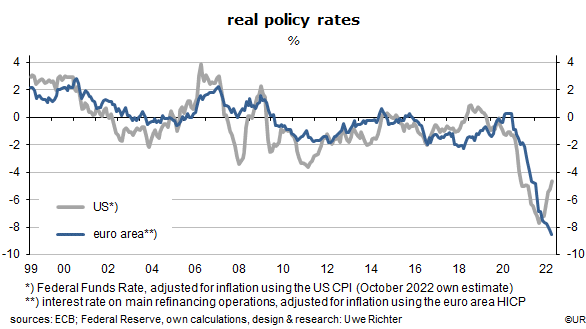
Market Commentary: European inflation and interest rates continue to rise – for a longer time than expected
Dieter Wermuth, Economist and Partner at Wermuth Asset Management
Last week I had argued that European inflation rates would soon come down significantly – a result of the weakening economy, steeply falling prices of important commodities, and because the prices of bonds and stocks as well as, apparently, of real estate were on the way down this year. Asset prices were hit by rising long-term interest rates which, in turn, were pushed up by higher policy rates. This is still the most likely scenario, but it will take longer than I had thought. There is too much pressure in the pipeline.
Compared to the US, neither European industrial producer nor consumer price inflation has calmed down recently. Germany’s PPI, for instance, was up 45.8% y/y in September, and when I look at the seasonally adjusted numbers for the three months before and extrapolate them for a full year, I get a shocking annualized rate of 83%. Things seem to get out of hand in that part of the value chain.
Last Friday the Federal Office of Statistics reported that in October German consumer prices were 10.4% higher than twelve months ago. On the basis of the harmonized consumer price index (HICP) – which is used for the calculation of euro area inflation, the rate was 11.6% y/y. Italy’s was even higher: 12.8%. According to yesterday’s press release by Eurostat, the result for the euro area as a whole was 10.7% y/y, and thus 13% on a 3-month annualized basis.
Last summer, the ECB had decided to get rid of its forward guidance tool which it had used to send signals to market participants about the intended future trajectory of policy rates. The idea was to reduce market volatility and risk premia and in this way stimulate capital spending and economic growth. As it turned out, the gap between aspiration and reality became too large during recent market turbulences – markets did not what the ECB had expected them to do. In the meantime, the ECB has become less ambitious and more modest. It is now data-driven and thus less error-prone, admitting that it does not really understand what is driving the European economy in the near term. Welcome to the Club of the Clueless!
And the bottom line? If the ECB wants to remain (or become?) credible, it has no choice but to raise policy rates as long as actual inflation is so much higher than the medium-term target of 2%. I am sure that the road ahead is quite long: the so-called professional forecasters who are regularly consulted by the ECB have just raised their inflation forecast for 2023 from 3.6% to 5.8% y/y.
We have to prepare ourselves for further large hikes of the main refinancing rate, from its present 2.0% to at least 4%. Even such a level is far in negative territory given the expected inflation rates next year – and has thus expansionary effects. For the foreseeable future, policy rates will continue to push up the whole European yield curve, both the short and the long end. As in the US, it might become inverted, with, for instance, a 3-month Euribor rate of 5% and a 10-year yield of Bunds of 4%. When this becomes market consensus at some point soon, it would stop the bear market rally of equities in its tracks. They would then descent to more reasonable price levels. A sell-out of bonds and real estate would also become likely. Never bet against the ECB?
The hour of giving some serious thoughts about your portfolio risks is near.

I sometimes wonder how much of today’s record high inflation rates is due to ECB policies. Because deflation had been a dangerous possibility, the central bank had pursued a zero-interest rate policy for several years. Adjusted for actual inflation, the main policy rate had been negative for no less than ten years. Over an economic cycle, the “normal” rate should fluctuate around the trend rate of Europe’s potential GDP, ie, at 1–1¼%. In other words: the ECB had been very expansionary and is therefore partly to blame for today’s inflationary excesses. It is not just Russia. I have to admit, though, that I had also been on the deflation bandwagon. It had looked quite dangerous at times.
I also wonder why European long-term inflation expectations are still so low. The forecasters of the ECB predict that future inflation rates will average just 2.2% while the yield of 10-year Bunds is a more than modest 2.1% – investors seem to have even lower expectations.
###
For more information please contact:
Instinctif Partners
Lars Hofer
E lars.hofer@instinctif.com
T +49 162 562 8917
Visit us: https://wermutham.com/
Follow us on Twitter and LinkedIn
About Wermuth Asset Management
Wermuth Asset Management (WAM) is a Family Office which also acts as a BAFIN-regulated investment consultant.
The company specializes in climate impact investments across all asset classes, with a focus on EU “exponential organizations” as defined by Singularity University, i.e., companies which solve a major problem of humanity profitably and can grow exponentially. Through private equity, listed assets, infrastructure and real assets, the company invests through its own funds and third-party funds. WAM adheres to the UN Principles of Responsible Investing (UNPRI) and UN Compact and is a member of the Institutional Investor Group on Climate Change (IIGCC), the Global Impact Investing Network (GIIN) and the Divest-Invest Movement.
Jochen Wermuth founded WAM in 1999. He is a German climate impact investor who served on the steering committee of “Europeans for Divest Invest”. As of June 2017, he was also a member of the investment strategy committee for the EUR 24 billion German Sovereign Wealth Fund (KENFO).
Legal Disclaimer
The information contained in this document is for informational purposes only and does not constitute investment advice. The opinions and valuations contained in this document are subject to change and reflect the viewpoint of Wermuth Asset Management in the current economic environment. No liability is assumed for the accuracy and completeness of the information. Past performance is not a reliable indication of current or future developments. The financial instruments mentioned are for illustrative purposes only and should not be construed as a direct offer or investment recommendation or advice. The securities listed have been selected from the universe of securities covered by the portfolio managers to assist the reader in better understanding the issues presented and do not necessarily form part of any portfolio or constitute recommendations by the portfolio managers. There is no guarantee that forecasts will occur.
Read the full article in PDF format here: English.